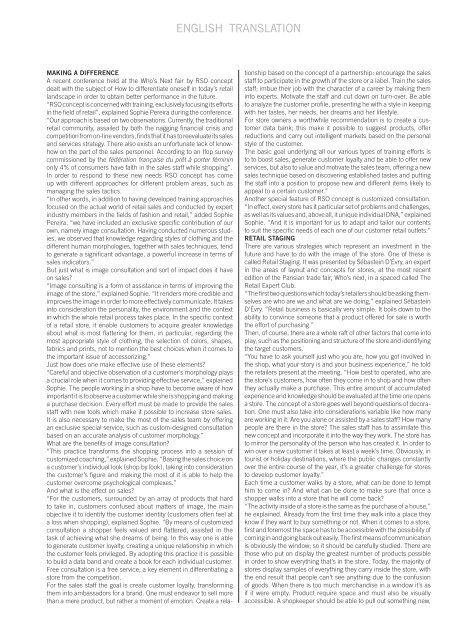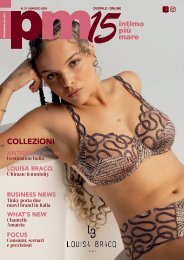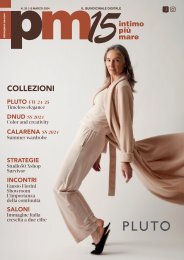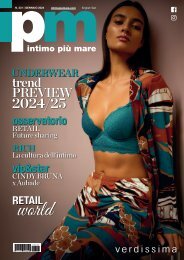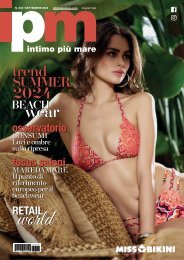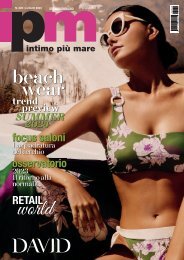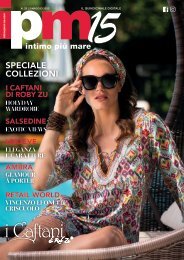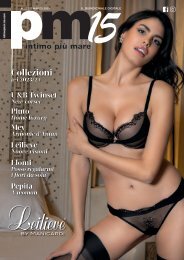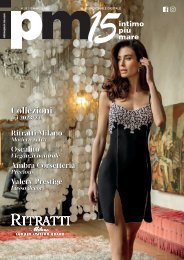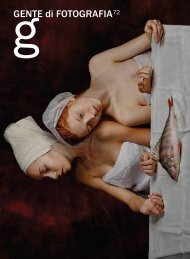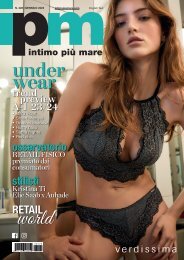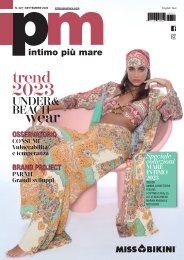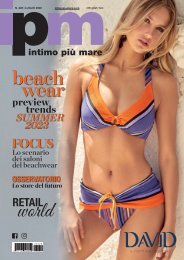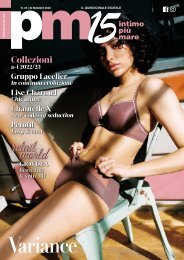Create successful ePaper yourself
Turn your PDF publications into a flip-book with our unique Google optimized e-Paper software.
ENGLISH TRANSLATION<br />
MAKING A DIFFERENCE<br />
A recent conference held at the Who’s Next fair by RSO concept<br />
dealt with the subject of How to differentiate oneself in today’s retail<br />
landscape in order to obtain better performance in the future.<br />
“RSO concept is concerned with training, exclusively focusing its efforts<br />
in the field of retail”, explained Sophie Pereira during the conference.<br />
“Our approach is based on two observations. Currently, the traditional<br />
retail community, assailed by both the nagging financial crisis and<br />
competition from on-line vendors, finds that it has to reevaluate its sales<br />
and services strategy. There also exists an unfortunate lack of knowhow<br />
on the part of the sales personnel. According to an Ifop survey<br />
commissioned by the fédération française du prêt à porter féminin<br />
only 4% of consumers have faith in the sales staff while shopping”.<br />
In order to respond to these new needs RSO concept has come<br />
up with different approaches for different problem areas, such as<br />
managing the sales tactics.<br />
“In other words, in addition to having developed training approaches<br />
focused on the actual world of retail sales and conducted by expert<br />
industry members in the fields of fashion and retail,” added Sophie<br />
Pereira, “we have included an exclusive specific contribution of our<br />
own, namely image consultation. Having conducted numerous studies,<br />
we observed that knowledge regarding styles of clothing and the<br />
different human morphologies, together with sales techniques, tend<br />
to generate a significant advantage, a powerful increase in terms of<br />
sales indicators.”<br />
But just what is image consultation and sort of impact does it have<br />
on sales?<br />
“Image consulting is a form of assistance in terms of improving the<br />
image of the store,” explained Sophie. “It renders more credible and<br />
improves the image in order to more effectively communicate. It takes<br />
into consideration the personality, the environment and the context<br />
in which the whole retail process takes place. In the specific context<br />
of a retail store, it enable customers to acquire greater knowledge<br />
about what is most flattering for them, in particular, regarding the<br />
most appropriate style of clothing, the selection of colors, shapes,<br />
fabrics and prints, not to mention the best choices when it comes to<br />
the important issue of accessorizing.”<br />
Just how does one make effective use of these elements?<br />
“Careful and objective observation of a customer’s morphology plays<br />
a crucial role when it comes to providing effective service,” explained<br />
Sophie. The people working in a shop have to become aware of how<br />
important it is to observe a customer while she is shopping and making<br />
a purchase decision. Every effort must be made to provide the sales<br />
staff with new tools which make it possible to increase store sales.<br />
It is also necessary to make the most of the sales team by offering<br />
an exclusive special service, such as custom-designed consultation<br />
based on an accurate analysis of customer morphology.”<br />
What are the benefits of image consultation?<br />
“This practice transforms the shopping process into a session of<br />
customized coaching,” explained Sophie. “Basing the sales choice on<br />
a customer’s individual look (shop by look), taking into consideration<br />
the customer’s figure and making the most of it is able to help the<br />
customer overcome psychological complexes.”<br />
And what is the effect on sales?<br />
“For the customers, surrounded by an array of products that hard<br />
to take in, customers confused about matters of image, the main<br />
objective it to identify the customer identity (customers often feel at<br />
a loss when shopping), explained Sophie. “By means of customized<br />
consultation a shopper feels valued and flattered, assisted in the<br />
task of achieving what she dreams of being. In this way one is able<br />
to generate customer loyalty, creating a unique relationship in which<br />
the customer feels privileged. By adopting this practice it is possible<br />
to build a data band and create a book for each individual customer.<br />
Free consultation is a free service, a key element in differentiating a<br />
store from the competition.<br />
For the sales staff the goal is create customer loyalty, transforming<br />
them into ambassadors for a brand. One must endeavor to sell more<br />
than a mere product, but rather a moment of emotion. Create a relationship<br />
based on the concept of a partnership: encourage the sales<br />
staff to participate in the growth of the store or a label. Train the sales<br />
staff; imbue their job with the character of a career by making them<br />
into experts. Motivate the staff and cut down on turn-over. Be able<br />
to analyze the customer profile, presenting he with a style in keeping<br />
with her tastes, her needs, her dreams and her lifestyle.<br />
For store owners a worthwhile recommendation is to create a customer<br />
data bank; this make it possible to suggest products, offer<br />
reductions and carry out intelligent markets based on the personal<br />
style of the customer.<br />
The basic goal underlying all our various types of training efforts is<br />
to to boost sales, generate customer loyalty and be able to offer new<br />
services, but also to value and motivate the sales team, offering a new<br />
sales technique based on discovering established tastes and putting<br />
the staff into a position to propose new and different items likely to<br />
appeal to a certain customer.”<br />
Another special feature of RSO concept is customized consultation.<br />
“In effect, every store has it particular set of problems and challenges,<br />
as well as its values and, above all, it unique individual DNA,” explained<br />
Sophie. “And it is important for us to adapt and tailor our contents<br />
to suit the specific needs of each one of our customer retail outlets.”<br />
RETAIL STAGING<br />
There are various strategies which represent an investment in the<br />
future and have to do with the image of the store. One of these is<br />
called Retail Staging. It was presented by Sébastein D’Évry, an expert<br />
in the areas of layout and concepts for stores, at the most recent<br />
edition of the Parisian trade fair, Who’s next, in a spaced called The<br />
Retail Expert Club.<br />
“The first two questions which today’s retailers should be asking themselves<br />
are who are we and what are we doing,” explained Sébastein<br />
D’Évry. “Retail business is basically very simple. It boils down to the<br />
ability to convince someone that a product offered for sale is worth<br />
the effort of purchasing.”<br />
Then, of course, there are a whole raft of other factors that come into<br />
play, such as the positioning and structure of the store and identifying<br />
the target customers.<br />
“You have to ask yourself just who you are, how you got involved in<br />
the shop, what your story is and your business experience,” he told<br />
the retailers present at the meeting. “How best to operated, who are<br />
the store’s customers, how often they come in to shop and how often<br />
they actually make a purchase. This entire amount of accumulated<br />
experience and knowledge should be evaluated at the time one opens<br />
a store. The concept of a store goes well beyond questions of decoration.<br />
One must also take into considerations variable like how many<br />
are working in it. Are you alone or assisted by a sales staff? How many<br />
people are there in the store? The sales staff has to assimilate this<br />
new concept and incorporate it into the way they work. The store has<br />
to mirror the personality of the person who has created it. In order to<br />
win over a new customer it takes at least a week’s time. Obviously, in<br />
tourist or holiday destinations, where the public changes constantly<br />
over the entire course of the year, it’s a greater challenge for stores<br />
to develop customer loyalty.”<br />
Each time a customer walks by a store, what can be done to tempt<br />
him to come in? And what can be done to make sure that once a<br />
shopper walks into a store that he will come back?<br />
“The activity inside of a store is the same as the purchase of a house,”<br />
he explained. Already from the first time they walk into a place they<br />
know if they want to buy something or not. When it comes to a store,<br />
first and foremost the space has to be accessible with the possibility of<br />
coming in and going back out easily. The first means of communication<br />
is obviously the window; so it should be carefully studied. There are<br />
those who put on display the greatest number of products possible<br />
in order to show everything that’s in the store. Today, the majority of<br />
stores display samples of everything they carry inside the store, with<br />
the end result that people can’t see anything due to the confusion<br />
of goods. When there is too much merchandise in a window it’s as<br />
if it were empty. Product require space and must also be visually<br />
accessible. A shopkeeper should be able to pull out something new,


